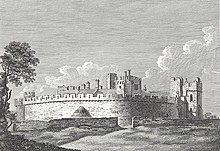Stradling (family)
The Stradling family was an English - Welsh or British noble family.
origin
According to the family history of Edward Stradling from the late 16th century, the family came from the Baltic Sea region. The progenitor of the family is said to have come to England during the Norman conquest . His descendant Sir William Stradling was one of the twelve knights with whom Robert Fitzhamon conquered South Wales in 1090. In gratitude he received St Donat's Castle . However, this story is completely unfounded and unfounded. In fact, the ancestor of the family was Johann von Strättligen , who came from the Strättligen family in the Bernese Oberland . This was one of the nobles who followed Eleanor of Provence , wife of King Henry III. , came to England. Johann von Strättligen served the English crown and was rewarded with land ownership.
Acquisition of extensive estates in Wales and England
Johann's son Peter Stradelinges acquired St Donat's Castle in Glamorgan through marriage at the beginning of the 14th century, as well as other property in south-west England, which he held as a vassal of various liege lords. Over the next few generations, the family acquired further properties in Glamorgan, but also in Monmouthshire in South East Wales and estates in Somerset , Wiltshire , Oxfordshire and Dorset . Numerous members of the family were knighted, and Edward Stradling (1389-1453) received important and lucrative offices in Wales through the influence of his father-in-law, later Cardinal Beaufort . With the early death of his grandson Thomas Stradling in 1480, the family suffered losses from a long administration of minorities, but they were not drawn into the turmoil of the final phase of the Wars of the Roses . After Wales had been fully incorporated into England around 1535 and was thus allowed to send representatives to Parliament , several members of the family were elected as members of the House of Commons . The family identified strongly with Glamorgan in the 16th and 17th centuries. As one of the leading Anglo-Welsh families in the region, they promoted the Welsh language and delved into their own family history and the history of the region.
Rise in the hereditary nobility and extinction of the main line
In 1611, John Stradling was able to acquire the hereditary title of baronet , of St Donat’s in the County of Glamorgan , which the heads of the families held from then on. During the English Civil War , numerous members of the family fought on the king's side. The 3rd Baronet died of injuries sustained in battle, and the family properties were so badly damaged that the 5th Baronet still felt the financial consequences. Yet the family's income from their estates is believed to have been around £ 5,000 a year in the early 18th century. The main line of the family thus belonged to the leading families of the gentry of Glamorgan, but it did not achieve the political importance of the Herbert and Mansel families . With the childless death of the 6th baronet , the main line of the family died out in the male line in 1738 and the title of baronet became extinct. Most of the possessions initially fell to his relative Bussy Mansel , but after his childless death in 1750, the property was divided up in a lengthy process of inheritance. The famous library of St Donat's, which the scholar Edward Mansel in particular had begun to build in the mid-16th century, had already been sold and dispersed.
Master list (extract)
-
John de Estratlinges († around 1293)
-
Peter Stradelinges († before 1314)
- Sir Edward Stradling († around 1363)
- Sir Edward Stradling († around 1394)
- Sir William Stradling († before 1412)
- Sir Edward Stradling (1389-1453)
- Sir Henry Stradling (1423-1476)
- Thomas Stradling († 1480)
-
Edward Stradling (around 1472-1535)
-
Thomas Stradling († 1571)
- Sir Edward Stradling (around 1529–1609)
- David Stradling (before 1537 – after 1575)
-
Thomas Stradling († 1571)
- Henry Stradling
- Francis Strading
- Sir John Stradling, 1st Baronet (1563-1637)
- Sir Edward Stradling, 2nd Baronet (1601-1644)
- Sir Edward Stradling, 3rd Baronet (around 1624 – before 1646)
- Sir Edward Stradling, 4th Baronet († 1685)
- Sir Edward Stradling, 5th Baronet (around 1672-1735)
- Edward Stradling (1699-1726)
- Sir Thomas Stradling, 6th Baronet (1710–1738)
- Sir Edward Stradling, 5th Baronet (around 1672-1735)
- Sir Edward Stradling, 4th Baronet († 1685)
- Sir Edward Stradling, 3rd Baronet (around 1624 – before 1646)
- George Stradling (1621–1688)
- Sir Henry Stradling († uncertain: 1649)
- Sir Edward Stradling, 2nd Baronet (1601-1644)
- Sir John Stradling, 1st Baronet (1563-1637)
- Francis Strading
-
Edward Stradling (around 1472-1535)
- Thomas Stradling († 1480)
- Sir Henry Stradling (1423-1476)
- Sir Edward Stradling (1389-1453)
- Sir John Stradling († around 1435)
- Sir William Stradling († before 1412)
- Sir Edward Stradling († around 1394)
- Sir Edward Stradling († around 1363)
-
Peter Stradelinges († before 1314)
literature
- Ralph A. Griffiths: The rise of the Stradlings of St Donat's . In: Morgannwg , 7 (1963), pp. 15-47.
Web links
- Evan David Jones: STRADLING family of Glamorganshire . In: Dictionary of Welsh Biography. 1959.
- RA Griffiths: Stradling [Stradelinges, de Estratlinges] Family (per. C. 1290-1480). In: Henry Colin Gray Matthew, Brian Harrison (Eds.): Oxford Dictionary of National Biography , from the earliest times to the year 2000 (ODNB). Oxford University Press, Oxford 2004, ISBN 0-19-861411-X , ( oxforddnb.com license required ), as of 2004
Individual evidence
- ↑ Christian Hesse: strategies of survival. Challenges for the lower nobility in the 13th / 14th centuries Century . In: Berner Zeitschrift für Geschichte , 75 (2013), p. 22.
- ^ History of Parliament online: STRADLING, Sir Edward, 5th Bt. (1672–1735), of St. Donat's Castle, Glam. Retrieved May 9, 2020 .

